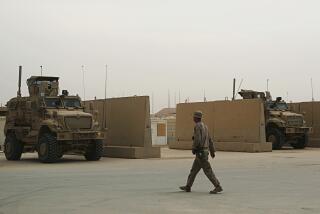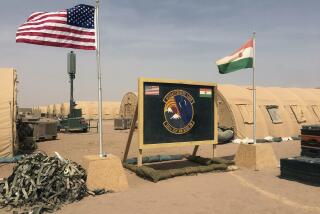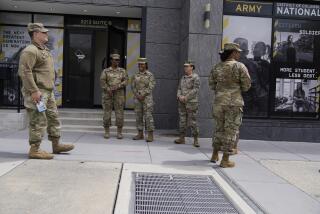U.S. Plans Massive Rotation of Troops
WASHINGTON — The Pentagon is preparing to rotate a quarter of a million troops into and out of Iraq, Kuwait and Afghanistan early next year in a massive and risky undertaking that could leave them highly vulnerable to attacks during the changeover.
The plan, which will replace virtually all of the United States’ battle-hardened forces with new fighters, calls for substituting about 118,000 troops for 130,000 outgoing soldiers in Iraq alone. The large-scale rotation worries top military officials, who have choreographed the five-month process down to the smallest details.
“It’s appropriate to be worried about it,” Defense Secretary Donald H. Rumsfeld acknowledged Tuesday.
The undertaking is the result of two controversial decisions made by Pentagon planners. The first was to send troops home after serving 12 months in Iraq as a way to sustain morale and prevent reenlistment rates from plummeting. The second was to deploy fighting units together, rather than subbing in new soldiers on an individual basis -- a “spare parts” policy that proved disastrous in Vietnam.
But by promising troops they could go home after a defined period, the Pentagon may have boxed itself into a particularly arduous rotation schedule, some military analysts said.
“They’re driven by the fact that though they claim this was a war of necessity, it’s really a war of choice,” said Lawrence J. Korb, who was assistant secretary of Defense in the Reagan administration. “Because it’s a war of choice, if they don’t get those troops out of there they are going to cause long-term problems for the U.S. military, because they will have horrible reenlistment rates.”
Fresh but Green
The vast movement of forces from January through May is described by the military itself as unprecedented in scope and risk. Not even during World War II were so many troops with their planes, ships and combat equipment transported into and out of a combat zone in such a short time.
With attacks against U.S. troops a daily fact of life in Iraq, Pentagon officials say they are bracing for the possibility that insurgents could strike during the mass changing of the guard. The fresh troops also could have difficulty maintaining the offensive.
Even after the troops are in place, Army officials fear they could be at a security and strategic disadvantage without the on-the-ground savvy that only the departing forces will have.
“You lose situational awareness, you lose relationships, you lose the experience,” Rumsfeld said. “The people going over are ready, but the people there are experienced and really know their stuff. And who would you rather have there?”
On the home front, tens of thousands of returning soldiers will need medical care for injuries or illnesses contracted during their deployment. Army officials say they will need to build new barracks and augment care at base hospitals to handle the influx. But they haven’t started.
“In the next four months, we’re going to pull off a logistics feat that’ll rival any in history, I think, as we move a major part of the Army,” said Air Force Gen. Richard B. Myers, chairman of the Joint Chiefs of Staff. “It’s going to be a very big project that we’ve been planning for a very long time, so there’s going to be a lot of turbulence in the system.”
A senior Army official involved in preparing for the move said that planners at every level have been puzzling out the challenge for months.
“We’ve got to do it in such a way that we maintain the offensive in [Iraq and Afghanistan] and we maintain the security environments at the same time,” the official said, speaking on condition of anonymity. “It’s kind of like a hockey team. You don’t want to be left out there with the goalie exposed.”
About 130,000 soldiers of the Army’s 82nd Airborne, 101st Airborne, 1st Armored and 4th Infantry divisions are slated to return from Iraq, to be replaced simultaneously by about 118,000 troops from two other Army divisions, a Marine Corps contingent and a “division equivalent” force drawing on reservists and the National Guard. A fourth Army division will rotate into Afghanistan.
The troops on the move total more than half the Army’s approved strength of 481,000 active and reserve forces. They will be transported more than 6,000 miles on ships and planes along with tens of thousands of pieces of equipment.
Possible Logjam
When the returning troops reach U.S. shores, the Army will face another trial as it scrambles to muster adequate barracks and medical staff to handle the crush of soldiers expected to need medical evaluations and treatment.
Those troops will be competing for space at facilities already crowded with reservists for whom the Army has ordered medical care before they are deployed. About 40% of the troops heading to war are reservists, compared with 20% of the force now in place.
In an example of the kind of administrative logjam -- and resulting soldier distress -- that worries Army authorities, about 630 Army National Guard and Reserve troops at Ft. Stewart, Ga., were on “medical hold” for months this year awaiting medical or dental care. They were living in substandard barracks meant for short-term training, lacking climate-control systems and indoor toilets.
“Under the current rules, [reservists] get one physical every five years, and quite frankly we’ve got real problems in dental readiness,” Army Chief of Staff Gen. Peter J. Schoomaker told senators last month. “So when we mobilize soldiers and bring them on out of the Reserve component, if they are not medically ready, we now are liable and responsible to ... correct their problems before they return to the system.”
Military planners are massaging the multitude of details of the rotation -- where and when helicopters will take troops and over what routes, how to mass departing troops in the few airports and airstrips in Iraq without making them sitting ducks and assigning hundreds of soldiers to guard the routes.
“This will be a combat operation from start to end,” said one Army official, asked about the security risks. “This will not be an administrative move, OK?”
Retired Army Lt. Gen. William “Gus” Pagonis, who directed military logistics during the Persian Gulf War, said Army experts are preparing complex computer models and gaming out scenarios to smooth the obstacles of the move.
“Even if in the U.S. we tried to move 220,000 people out of one airport, it would be a nightmare,” Pagonis said. “The magnitude of all this happening simultaneously, there in Iraq, is just overwhelming.”
More to Read
Sign up for Essential California
The most important California stories and recommendations in your inbox every morning.
You may occasionally receive promotional content from the Los Angeles Times.









